Ptolemy’s Map of Ireland – Part 6
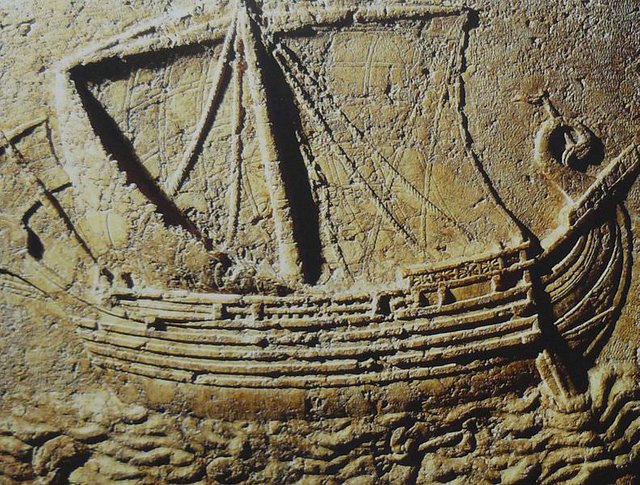
Speed Under Sail of Ancient Ships
How fast did ships sail in the ancient world? More than sixty years ago, this question was explored by Lionel Casson, Professor of Classics at New York University. His article, Speed Under Sail of Ancient Ships, which appeared in the Transactions of the American Philological Association in 1951, rendered previous work in the field redundant. Casson consulted all the primary sources that had a bearing on the subject and examined them in the light of modern hydrographic information, which was provided by the United States Hydrographic Office:

To determine the rate of speed of the voyages recorded in ancient literature, we must first distinguish between those made under fair and those under foul winds. Fortunately, in many cases we are specifically told what the wind conditions during the voyage were. Where we are not told we can often, by using modern hydrographic information concerning prevailing winds, make a very good guess ... The same winds prevail today as in the days of the ancients ... Nelson in 1798 met the identical winds encountered in a voyage described by Lucian. (Casson 138 ... 138 fn 8)
The difference between the two—voyages made under fair winds and voyages made under foul winds—could be considerable:
An excellent case in point is the voyage from Alexandria to Rome which could take as much as five times as long as the return. (Casson 138 fn 7)
Most sources give sailing times in days, while some specify days and nights. But how many hours of actual sailing does a day comprehend? 24 hours? 12 hours? 6 hours? In his article, Casson clearly understands one day’s sail to mean a full twenty-four hours under sail unless otherwise stated:
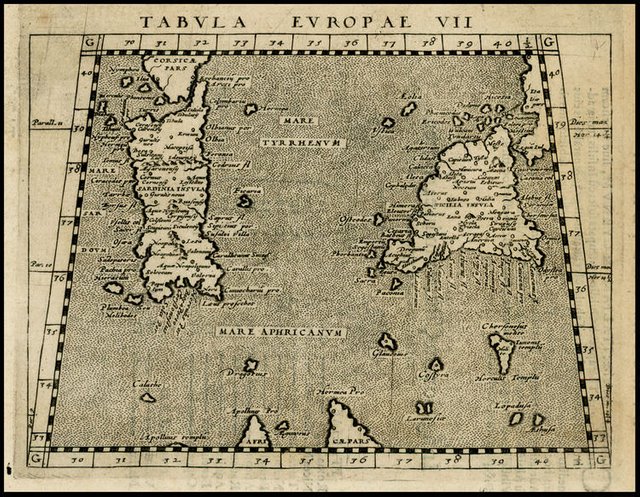
Then there is the circumnavigation of Sicily to which we have references in Thucydides, Strabo and Plutarch. On such a course a ship would theoretically meet both favorable and unfavorable winds. Strabo (6.2.1) quotes Ephorus as saying that the circumnavigation took 5 days and nights. Since the distance is roughly 500 nautical miles, the speed works out to 4.2 knots. Plutarch (Mor. 603A) says 4 days, which would mean 5.2 knots. Thucydides (6.1) gives 8 days. Unquestionably he means traveling by day only (cf. 2.97 where he specifies sailing day and night). If we allow 15 hours a day for travel, he agrees with Strabo; if less, with Plutarch. In any event, all the figures indicate that, in going around Sicily, vessels met more fair winds than foul. (Casson 143 fn 34)
After much discussion, Casson comes to the following conclusions:
When we combine all the above evidence we find that under favorable wind conditions, ancient vessels averaged between 4 and 6 knots over open water, and 3 to 4 knots while working through islands or along coasts. (Casson 142)
We can therefore conclude that ancient vessels averaged from less than 2 to 2½ knots against the wind. (Casson 143)
| Conditions | Minimum | Average | Maximum |
|---|---|---|---|
| Favourable | 3 knots | 3.5 knots | 4 knots |
| Average | <2.5 knots | ~2.75 knots | 3.25 knots |
| Unfavourable | < 2 knots | ~2 knots | 2.5 knots |
Casson estimates that with favorable wind and currents a speed of 3 to 4 knots could be logged when sailing along coasts. Roughly speaking, that’s about 5.5–7.5 kph. As it happens,
1 knot = 1852 m hr–1
Ptolemy measured distances in stadia, and it is believed that the Ptolemaic stadion was equal to about 185 m (Cuntz 110-111). So 1 knot is almost precisely equal to 10 stadia hr–1. In Ptolemy’s terms, then, the top speed would have been about 40 stadia hr1, and the slowest speed less than 20 stadia hr–1.
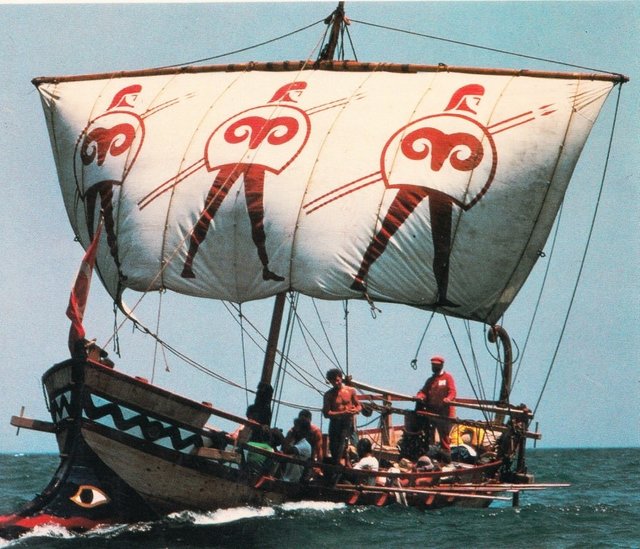
Tim Severin’s Voyages
Casson’s figures were derived from ancient accounts. We do, however, also have the results of actual voyages made in the modern era using replica vessels. The best known are the voyages made by the British explorer Tim Severin.
In 1984 and 1985, Severin undertook two voyages in the Mediterranean and Black Seas: The Jason Voyage recreated the legendary trip from Greece to Colchis made by Jason in the Argo, while the Ulysses Voyage recreated the wanderings of Odysseus from Troy to Ithaca. The vessel used in both voyages was a modern replica of an early Greek galley. Although Severin’s 16-metre Argo was a sailing ship, its principal mode of locomotion was by oar, not sail.

I realized how extraordinarily lucky we had been the previous year going out of the Aegean Sea towards the Marmara in the wake of Jason and his Argonauts. Then we had been blessed with a rare southerly wind which had sent Argo skimming forward over the surface of the water at six to seven knots, but the land had moved past at only half that speed as the mass of water on which we floated slid in the opposite direction. (Severin 386-389)
The more consistent evidence shows that oared ships (and that included the Mediterranean galleys of the Venetians) averaged something in the region of two knots on long journeys as the constant grind of rowing day after day sapped the energy of the rowers. (Severin 1795-1798)
Argo on her 1,500-mile [2400-km] coasting voyage to Soviet Georgia had settled down to a daily average of some twenty-five to thirty miles [40-50 km] per day, stopping each night on the shore so that the crew could stretch out on the beach and get a decent rest after five to ten hours’ hard drudgery on the oars. (Severin 1799-1801)
They were wonderful company, full of good humour and energy, and by the time they left Spetses two weeks later they had worked out the best way of rowing the boat, and succeeded in getting Argo up to the very respectable speed of 6 knots. (Severin 4641-4643)
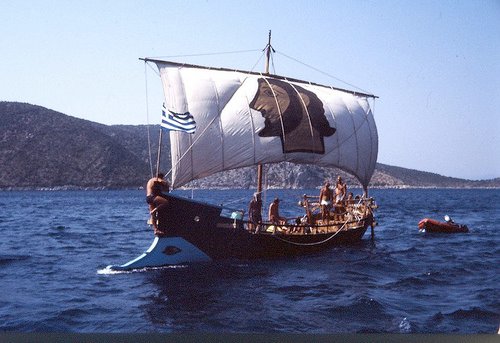
So the early galley voyages proceeded by fits and starts, the occasional spectacular passages of over a hundred miles [160 km] in a day interspersed with long periods of waiting. (Severin 763-764)
Decrease Ulysses’ average speed to a near-drift, say twenty miles [30 km] a day ... (Severin 3291)
Argo, then, could be rowed or sailed at speeds of up to 6-7 knots, while 2-4 knots was considered respectable. At very slow speeds, up to 30 km could still be covered in one day.
| Conditions | Minimum | Average | Maximum |
|---|---|---|---|
| Favourable | 3 knots | 4.5 knots | 6 knots |
| Average | 2 knots | 3 knots | 4 knots |
| Unfavourable | 1 knot | 1.5 knots | 2 knots |
These figures are more or less consistent with the results of Casson’s research. For coasting voyages, then, speeds of less than 2 knots were to be expected in unfavourable circumstances, while 4 knots was a typical or average speed, and 6 knots were to be regarded as exceptional.
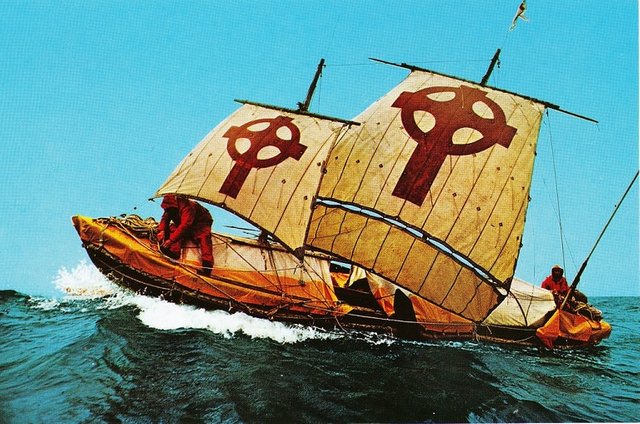
Sailing in Irish Waters
In the vicinity of Ireland, the prevailing wind direction today is roughly westerly to south-westerly:
The general surface currents in this area are continuations of the east-northeast-setting North Atlantic Current. These currents are influenced greatly by winds, and at times their speed and direction may vary considerably from the seasonal patterns. Since the prevailing wind is westerly on the west coast of Ireland, the prevailing surface drift is toward the land and northward. Within the Irish Sea the inflow of oceanic water is augmented by considerable land drainage, and consequently the outflow at North Channel is greater than the inflow at St. Georges Channel. (Sailing Directions for Ireland 20)
In Ireland, winds from all directions may occur in any given month but the predominant winds are from directions between south and west with these directions occurring in about 40 percent of the observations. Winds from the southwest quadrant are most frequent in midwinter and are again prominent in summer, particularly in July and August. During the remainder of the year winds from south through west are more frequently displaced by winds from northerly directions. From March to May northeasterly winds become frequent while northerly winds are common in April, especially to the westward of Ireland. (Sailing Directions for Ireland 60)
Sailing in an anticlockwise direction around Ireland during the summer, one would encounter predominantly favourable winds in the Irish Sea (east coast) and in the Celtic Sea (south coast), and predominantly unfavourable winds on the north and west coasts. And vice versa if one were sailing in a clockwise direction.
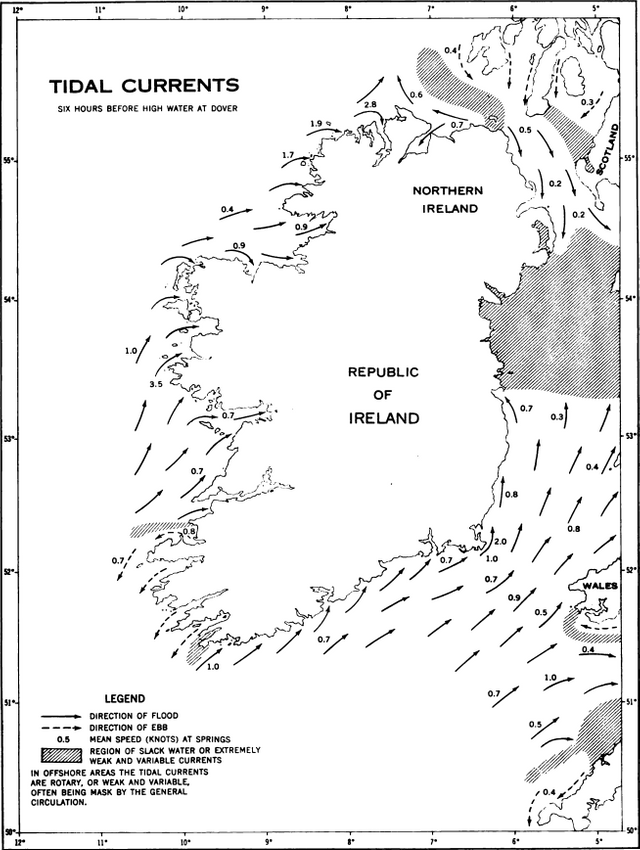
Tidal currents set southeastward through the narrows of North Channel at the same time that they set northward through St. Georges Channel. Although at springs the speeds of both the flood and ebb in North Channel reach 6 knots close to headlands, their average rate is about 3 knots, increasing to 5 knots near Mull of Cantyre (Pub. 33) and to 4 knots near Torr Head. Off Mull of Galloway (Pub. 33), tidal currents increase to 5 knots or more, part turning sharply around that promontory. (Sailing Directions for Ireland 20)
Some of these speeds are comparable to Casson and Severin’s top sailing speeds for ancient vessels. If your vessel is making 6 knots through the water, but the tidal current is running at 6 knots in the opposite direction, you are not actually making any headway relative to the coast. It is unlikely that ancient ships from the largely tideless Mediterranean would have even attempted to sail against the strong tidal currents they would have encountered in Irish waters. During neap tides, however, tidal currents would not have been as powerful.
In the unfamiliar waters of the Irish Sea and Atlantic Ocean, it is also unlikely that merchants or explorers would have risked sailing at night. But during the summer months, that would have left them with sixteen to eighteen hours of daylight for sailing.
In Irish waters, tides are semidiurnal. The tidal cycle is about 6.2 hours long. In other words, approximately six-and-a-quarter hours elapse between a high tide and the succeeding low tide, and vice versa. In a period of twenty-four hours, then, a captain would have a total of 12-13 hours of sailing with favourable currents, divided into two periods of six or so hours of sailing interrupted by one period of six or so hours of unfavourable currents. Even if the latter occurred during the daytime, he would still have ten to twelve hours of good sailing at his disposal during the summer.
It seems plausible to take 6-7 hours as the length of a half-day’s sail, and 12-14 hours as a full day’s sail.
Conclusion
In half a day, an ancient ship sailing along the coast of Ireland could cover 20–60 km on average.
| Conditions | Minimum | Average | Maximum |
|---|---|---|---|
| Favourable | 30 km | 50 km | 70 km |
| Average | 20 km | 40 km | 60 km |
| Unfavourable | 0 km | 10 km | 20 km |
However, there are so many factors involved in determining the speed under sail of ancient vessels that these figures should be taken with a grain of salt.
References
- Lionel Casson, Ships Under Sail in the Ancient World, Transactions of the American Philological Association, Volume 82, pp136‑148, The Johns Hopkins University Press, Baltimore, Maryland (1951)
- Otto Cuntz, Die Geographie des Ptolemaeus: Galliae, Germania, Raetia, Noricum, Pannoniae, Illyricum, Italia, Weidmann, Berlin (1923)
- Karl Wilhelm Ludwig Müller (editor & translator), Klaudiou Ptolemaiou Geographike Hyphegesis (Claudii Ptolemæi Geographia), Volume 1, Alfredo Firmin Didot, Paris (1883)
- Tim Severin, The Ulysses Voyage, Endeavour Press Limited, Kindle Edition (2013)
- United States, Sailing Directions for Ireland, H O Pub 30, United States Government Printing Office, Washington (1962)
- Friedrich Wilhelm Wilberg, Claudii Ptolemaei Geographiae, Libri Octo: Graece et Latine ad Codicum Manu Scriptorum Fidem Edidit Frid. Guil. Wilberg, Essendiae Sumptibus et typis G.D. Baedeker, Essen (1838)
Image Credits
- Bas-Relief Carving of a Phoenician Ship: Wikimedia Commons, Phoenician ship carved on the face of a sarcophagus of the 2nd century CE, National Museum of Beirut, © Elie plus at English Wikipedia, Creative Commons License
- Lionel Casson: © New York University, Fair Use
- Ptolemy’s Map of Sicily and Sardinia: Giovanni Antonio Magini, Public Domain
- Tim Severin’s Argo under Sail and Oar: The Jason Voyage, © Tim Severin, Fair Use
- Tim Severin: Wikimedia Commons, Creative Commons License
- Argo during the Ulysses Voyage: The Ulysses Voyage, © Tim Severin, Fair Use
- Tim Severin’s Brendan in the North Atlantic: The Brendan Voyage, © Tim Severin, Fair Use
- Tidal Currents in Irish Waters: Sailing Directions for Ireland, H O Pub 30, United States Government Printing Office, Washington (1962), Public Domain

Before this post i really don't know ireland history. Thanks for sharing @harlotscurse
And thank you for commenting.
Pleasure. Thanks for your reply. I will be wait to read your next post.
Well great post man informative post I really like it keep sharing such wonderful and informative post followed you for more similar post :)
Thank you for the kind remarks.
@harlotscurse great post.thanks for sharing.
Thanks. You're welcome.
its nice to know about history, thanks dear
@upvote done
Thnks for sharing us
Good writing brother. Keep it up